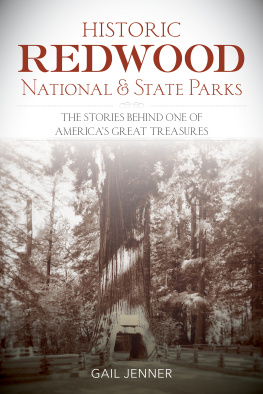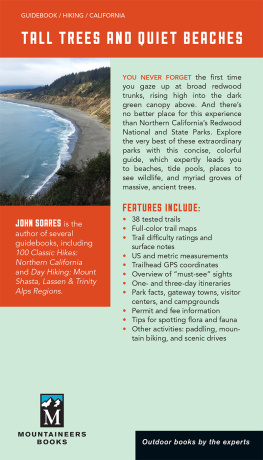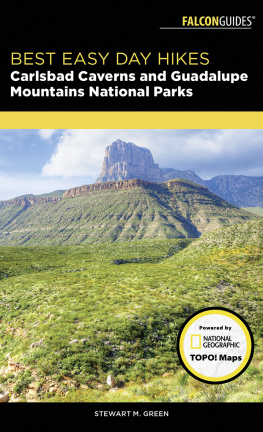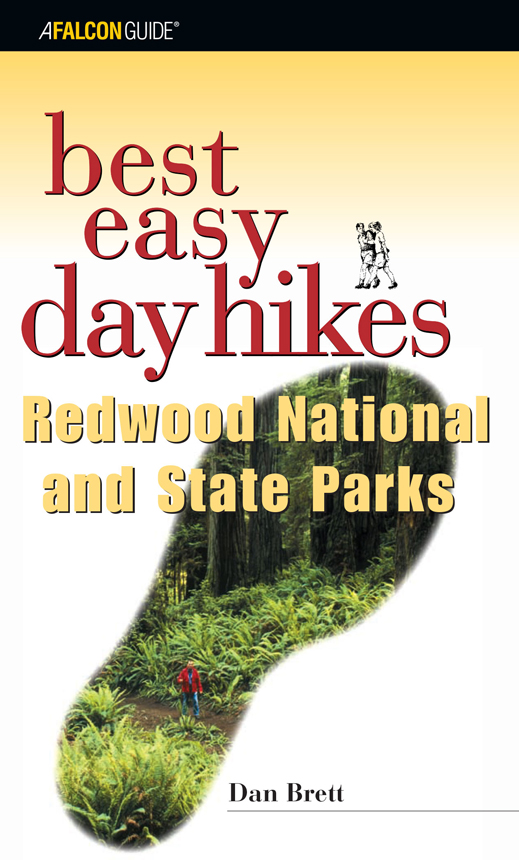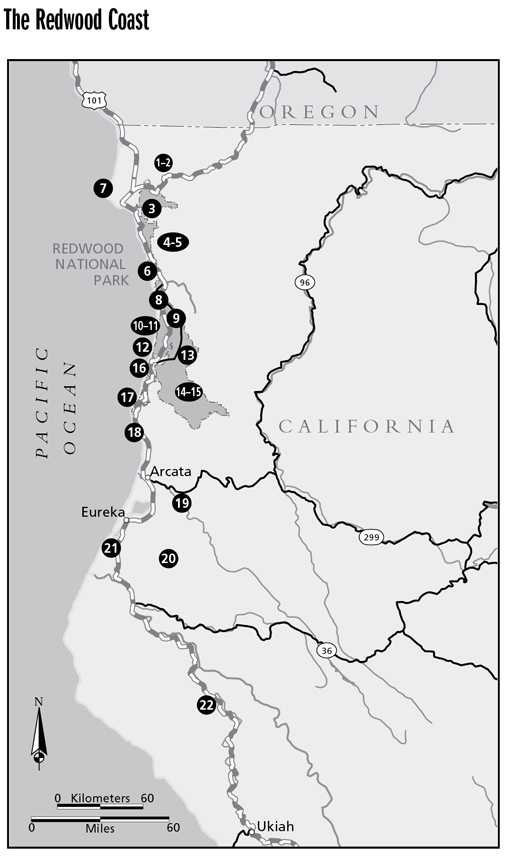Best Easy Day Hikes Series
Best Easy Day Hikes Redwood National and State Parks
Dan Brett
Help Us Keep This Guide Up to Date
Every effort has been made by the author and editors to make this guide as accurate and useful as possible. However, many things can change after a guide is publishedtrails are rerouted, regulations change, facilities come under new management, etc.
We would love to hear from you concerning your experiences with this guide and how you feel it could be improved and kept up to date. While we may not be able to respond to all comments and suggestions, well take them to heart and well also make certain to share them with the author. Please send your comments and suggestions to the following address:
The Globe Pequot Press
Reader Response/Editorial Department
P.O. Box 480
Guilford, CT 06437
Or you may e-mail us at:
editorial@GlobePequot.com
Thanks for your input, and happy travels!
Copyright 2005 by The Globe Pequot Press
All rights reserved. No part of this book may be reproduced or transmitted in any form by any means, electronic or mechanical, including photocopying and recording, or by any information storage and retrieval system, except as may be expressly permitted by the 1976 Copyright Act or by the publisher. Requests for permission should be made in writing to The Globe Pequot Press, P.O. Box 480, Guilford, Connecticut 06437.
Falcon and FalconGuide are registered trademarks of The Globe Pequot Press.
Maps created by XNR Productions, Inc. The Globe Pequot Press
The author used MapTech software to produce some source maps.
ISBN 978-1-4930-0540-6
The author and The Globe Pequot Press assume no liability for accidents happening to, or injuries sustained by, readers who engage in the activities described in this book.
Contents
The Hikes
Introduction
Among out-of-staters, California is probably best known for its movie stars, wacky politics, and iconic landmarks like the HOLLYWOOD sign and the Golden Gate Bridge. With all the glitz and hype, it is easy to forget that California is also a natural wonderland, full of rich and varied landscapes. Nowhere is this more true than in the redwood parks of Californias North Coast. Whether you like it wet, dry, high, low, perfectly level, or very nearly vertical, there is something here for you.
The obvious star of the redwood parks is Sequoia sempervirens , better known as the coast redwoodtallest living thing on Earth. Of the estimated two million acres of old-growth redwood existing at the time of European contact, only around 3 percent survive, most of them in the cluster of small parks that the hikes in this book explore. Sword ferns and cloverlike redwood sorrel carpet the forest floor under the thick, emerald canopies of these giants. In the east, the redwoods gradually give way to other species, including red and Douglas fir, Sitka spruce, incense cedar, Port Orford cedar, sugar pine, and several oak species. Directly on the coast, salt-sensitive redwoods leave a narrow strip to hardier plants such as Monterey cypress and coastal scrub species.
Wildlife here is easily as impressive as the flora. Hikers have a fair chance of seeing gray whales, sea lions, black bears, Roosevelt elk, and ospreys in appropriate spots and times. Mountain lions, bobcats, foxes, otters, marbled murrelets, and spotted owls also live here, though sightings are less likely. Californias rivers host impressive seasonal salmon runs, although, like the redwoods, theyre much diminished from historical levels.
Weather in the redwood region tends to produce wet winters and foggy summers, with summer heat increasing greatly just a few miles inland. Generally speaking, you are more likely to get rained on in winter, and seasonal bridges will all be removed at this time of year because creeks and rivers tend to swell dramatically with the rains. Since rain, wind, drizzle, and fog are common weather patterns on the coast in winter, you should bring waterproof shoes, wool socks, a good rain jacket, gloves, a hat, and even an extra set of dry clothes.
Rules and regulations vary from park to park and may change without notice. Check with the appropriate agencies before heading out, just to be sure. State parks generally require a day-use fee, but Redwood National Park and National Forest Service lands do not. Due to the ever-present fire danger, campfire permits are required on most public land throughout the state.
Zero Impact
The trails in the redwood parks of Californias North Coast are quite popular and sometimes can take a beating. Because of their popularity, we, as trail users and advocates, must be especially vigilant to make sure our passing leaves no lasting mark.
These trails can accommodate plenty of human travel if everyone treats them with respect. Just a few thoughtless, badly mannered, or uninformed visitors can ruin the trails for everyone who follows. The book Leave No Trace is a valuable resource for learning more about these principles.
Three Falcon Zero-Impact Principles
- Leave with everything you brought.
- Leave no sign of your visit.
- Leave the landscape as you found it.
Most of us know better than to litter. It is unsightly, polluting, and potentially dangerous to wildlife. Be sure you leave nothing, regardless of how small it is. Pack out all of your trash, including such biodegradable items as orange peels, which might attract area critters. Also consider picking up any trash that others have left behind.
Follow the main trail. Avoid cutting switchbacks and walking on vegetation beside the trail. Select durable surfaces, such as rocks, logs, or sandy areas, for resting spots.
Dont collect souvenirs, such as rocks, shells, feathers, driftwood, or wildflowers. Removing these items will detract from the next hikers experience.
Avoid making loud noises that may disturb others. Remember, sound travels easily along ridges and through canyons.
Finally, remember to abide by the golden rule of all hikers: If you pack it in, pack it out! Thousands of people coming behind you will be grateful for your courtesy.
Ranking the Hikes
Although the hikes in this book are relatively easy, some are longer and have more elevation change than others. Heres a list of the hikes in order of difficulty, from easiest to hardest.
Myrtle Creek Trail
Highlights: This is an easily accessible, short day hike with the feel of a backcountry wilderness area. The trail follows the course of a water diversion ditch that was used for a turn-of-the-twentieth-century hydraulic mining operation. Along the way, interpretive signs explain a little of the history and a lot about the diverse flora in the surrounding forest, part of the Myrtle Creek Botanical Area.
Distance: 2.1 miles out and back.
Approximate hiking time: 1.5 hours.
Best months: April through October.
Fees and permits: No fees or permits required.



